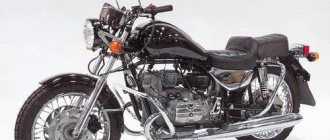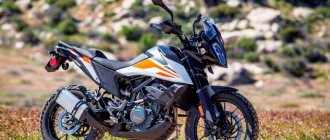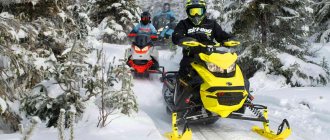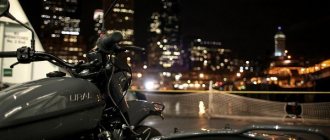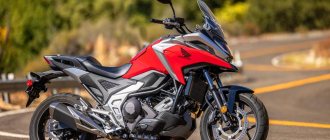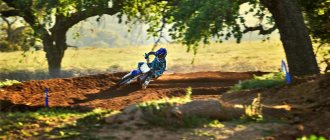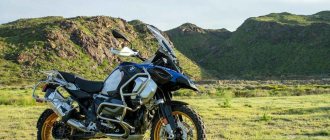One of the reasons to wait until '21 was to finally see the 2022 KTM 890 Adventure R, which was certainly one of the most anticipated models this year. And some were even luckier - getting it for a test drive. I have been looking forward to this meeting for a long time - given that this new product copes equally well with long trips and with fairly rough off-road conditions.
KTM 890 Adventure R 2022
The previous version, the KTM 790 Adventure R, was impressively good at the press tests that I was lucky enough to attend. And now I got the 890th version for a test drive, and pretty soon I put several hundred miles on it, mostly on asphalt, against my wishes. And the motorcycle continues to delight and impress. Let's first briefly recall what innovations distinguish the 890 Adventure R from the 790.
Let's start with the obvious: displacement. The 799cc LC8c inline twin that powers the 790 has been increased to 889cc, giving it a 90.7mm bore and 68.8mm stroke. Plus, the compression ratio was increased from 12.7:1 to 13.5:1, the valves were enlarged, the pistons were lightened, new connecting rods were installed and the timing cam profiles were changed. The throttle valves feature new sensors that measure intake manifold pressure to adjust the mixture in each cylinder individually, improving throttle response and more precise traction control. As a result, the new in-line twin produces 105 hp and 100 Nm of thrust. By the way, the same updates affected the KTM 890 Duke R, presented for 2022.
Well, we’ve sorted out the manufacturer’s data, let’s now discuss the real numbers. We put this big baby on the dyno, where it made 91.5 hp at 8,200 rpm and 86.5 lb-ft at 6,800 rpm. Compared to the real measurement of the 790 Adventure R, the increase was 7.5 hp and 8.8 Nm. Quite close to the manufacturer’s data, which declared an increase of 10 hp and 12 Nm. According to one expert, heavy and relatively slippery tires (our sample was shod with TKC80) are to blame for the lower measurement results, because the roller of our dyno is not rubberized enough and does not provide full grip with all tires.
In addition to the engine, the 890's transmission was also changed. The updated PASC light clutch has new discs. Gear shifting has become faster and easier thanks to a lighter spring and less claw travel between gears. The gears of the three upper gears are glass-blasted (polished with glass balls), which ensures higher mechanical reliability.
A lightweight subframe and an aluminum steering column tube distinguish the 890 chassis from previous versions, but the WP XPLOR suspension with a full range of adjustments remained virtually unchanged, minus modifications to the valves in the rear monoshock absorber. The low-mounted 20-liter tank is also unchanged.
The manufacturer claims that the rear brake caliper has 'isolated' pistons. The point is that the brake pads were thermally isolated from the pistons, which ensures more reliable brake operation in difficult conditions.
Some changes to the 2022 KTM 890 Adventure R don't sound so exciting. For example, a financial point: the recommended retail price for the US market, for example, is $14,199, that is, $500 more expensive than the 790 option. That's not a big deal in and of itself, but what do you think about the fact that Rally Mode, one of the best aspects of the 790 Adventure R, is now sold as an option for an extra 200 bucks? The Rally Pack includes adjustable traction control, an additional throttle response option and the actual Rally driving mode. You can also order the Tech Pack, which, in addition to all the Rally Pack options, also includes a bi-directional quickshifter and cruise control - this will cost an additional $550. Plus, apparently, ABS can no longer be turned off completely, but there is a choice between Road and Off-Road operating modes.
Video Review
Specifications
| Maximum engine power: | 94 hp (70 kW) HP |
| Torque: | 88 Nm Nm |
| Working volume: | 799 cm3 |
| Motor type (cylinder arrangement, number of strokes): | 2-cylinder, 4-stroke, DOHC Parallel twin |
| Number of cylinders: | 2 |
| Number of valves: | |
| Intake type (Injector / Carburetor): | |
| Bore and stroke: | |
| Starting system (Electric starter, kick starter): | |
| Cooling system: | Liquid cooling |
| Transmission (gearbox): | 6-speed, Quickshifter+ |
| Clutch (Dry / Wet): | |
| Drive unit: | Chain |
| Frame: | Steel |
| Chassis | |
| Suspension (front/rear travel): | |
| Brakes (Front/Rear): | |
| Wheels / Tires / Rubber: | |
| Dimensions and weight | |
| Dimensions (Length / Width): | |
| Seat height: | |
| Ground clearance: | |
| Curb weight: | |
| Weight: | 189 kg |
| Fuel tank capacity: | 20 l. |
| Battery capacity: | |
| Year of release: | |
| Country of Origin: |
What is he worth?
We also discussed the money issue, but the most important one remained: what is the 890 Adventure R worth compared to its competitors? Well, the 2022 KTM 890 Adventure R is a seriously off-road capable motorcycle, one of the most competent off-road tourers around. But there is one question: is the 2021 KTM 890 Adventure R worth the money compared to its smaller predecessor?
When the 890 Duke R replaced the 790 Duke, the contrast was stark: improved suspension, ergonomics, brakes, a superb 889cc engine, all for just an extra $1,200. Yes, the Brembo Stylema alone would cost about this money. In short, the new Duke eclipsed the old one without any options. But does the 890 Adventure R deserve to be asked for more?
The KTM 890 Adventure R is everything the 790 was and more. (Besides the Rally mode - here KTM punished themselves by making it a paid one, because the price difference between the 890 and 790 is also increased by the cost of this mode.) It has a more powerful engine, the transmission is better (minus the fact that from neutral The first one doesn’t always engage clearly, you have to roll it forward or backward a little, and the quickshifter on the test sample was not impressive). Many changes to the engine are imperceptible on the move, but make it more reliable and lighter, as well as a lighter subframe that allows the center of mass to be shifted lower, but all this overall does not particularly affect the feel of the motorcycle on the move. The 890 Adventure R weighs about the same as the 790, despite the larger engine - 212kg, which is quite decent for its segment. The WP suspension is still class leading and is one of the main reasons why the KTM Adventure leads the mid-sized touring bike segment. The brakes are powerful enough for sporty driving on the road and more than enough for off-road driving. The improvement of the rear brake is good news, but even in its previous form it suited me quite well, but gymkhana athletes will certainly appreciate that it is more difficult to overheat.
As for me, a significant advantage of the 890 is that the engine is more torquey at the bottom, and a 20% heavier crankshaft flywheel will help the engine stall much less often at low speeds. During my off-road test, I felt this quite clearly - it tried to stall less often in corners or when I slowly crept through difficult sections, but I can’t say that the difference was some kind of cosmic. But with traction and grip, the 890 handles noticeably better - it grips the ground like a professional off-road motorcycle, and even at the weakest level of traction control it confidently pulls forward.
However, the engine of the KTM 890 Adventure R has to be somewhat moderated off-road: in Road mode it is more angry than we would like for a comfortable ride. From the very bottom it is even somewhat sluggish, but if you give it a little gas, it sharply explodes, showing its temper. Fortunately, the electronics completely rein it in, and in Off-Road mode it delivers comfortable, controlled traction. By the way, the 790 has exactly the same character, taking into account slightly lower power figures: in Off-Road it is excellent as an enduro motorcycle, and in Road, a jerk of the gas at any speed and at any speed gives powerful acceleration, which is definitely addictive.
According to the dyno graphs, the 890 has basically the same character as its predecessor, just a little more power. Well, even if the differences between the new Adventure R and its predecessor are not as pronounced as those of the 890 Duke R, this does not make it worse.
Golden mean
When the Honda Africa Twin appeared a year ago, it turned out that it had no direct competitors. It fell into the inter-class gap between large tourers with a volume of about 1200 cm3 and noticeably weaker “mid-sized” ones. The concept was successful, but Honda's monopoly did not last long. The Austrians very quickly joined the new class with the KTM 1090 R, a simplified version of their top-end touring bike. Now supporters of the golden mean have plenty to choose from, and Motoexpert has something to compare with.
KTM 1090 Adventure R
KTM finally figured out that the Ready to Race concept is not relevant for all big enduro enthusiasts. For the most part, these people drive at moderate speeds, and they do not particularly need the cosmic power of the older “Adventure” vehicles, for which they have to pay a lot of money both when purchasing and during operation. This became especially noticeable with the release of 1290 Super Adventure. It is positioned as an off-road sportbike. But why 160 horsepower and a racing suspension for a person who drives in a straight line within the speed limits and rolls on the ground with his legs? Heeding the voice of reason, the Austrians this year released the 1090 Adventure R, a two-cylinder touring enduro with a class just below the top class and a volume just above a “liter”. The price, accordingly, is also more affordable. It happens that for such motorcycles the manufacturer makes deliberately simplified parts so that the owner is constantly reminded of how he saved money, bought not the best, and in his subconscious there was a desire to upgrade. The 1090 doesn't have this even close. The motorcycle looks like a full-fledged KTM, with everything in place except the fusion motor.
Claimed power is 1090 – 125 horsepower. It feels like there are even fewer of them, since the motorcycle reacts to manipulations with the gas handle not too violently, which is normal for enduro. The engine runs roughly, with extraneous noises, as if it is not working properly. This happens with Austrian engines; with such sounds they drive tens of thousands of kilometers just fine. Dealing with electronics without a manual is not easy. But once you figure it out, you can use it without any problems. The control system is beautifully implemented: there are basic modes, within which you can separately adjust the operation of ABS and traction control, or disable them completely. The anti-lock braking system has an off-road mode in which it only applies the front brake. It is very convenient if you are not one of the aces who let the front wheel of a heavy motorcycle slide in a controlled manner. The stern can be skidded into a turn, while steadily slowing down using the front brake, without the risk of overbraking. And for those for whom it is important to get there without tricks, but safe and healthy, ordinary ABS works very correctly both on the road and on the ground.
To the street, sports and rain engine modes implemented in many road motorcycles, the Austrians added an off-road one. There, the ABS and traction control settings are optimized for dirt driving, so there is no need to tinker with separate settings. The rear wheel can be driven either with the gas or with the brake, and the engine response is made softer, because it is, in principle, possible to cope with the usual characteristics of a liter V-Twin on a slippery surface, but with increased caution. And the “stifled” version produces more than enough power, but it is much easier to control.
The chassis is very light, the suspension copes well with off-road conditions. With certain rider skills, the 1090 Adventure R can go very fast on the ground and go into places where even light enduro bikes have a hard time. Ergonomics are also conducive to off-road exploits. Rich endour and rally experience allowed the Austrians to organize everything that is needed for a comfortable ride in a stand-up position. The steering wheel is set at the required height and width, your knees hold on to the tank, in general, you ride while standing with the same pleasure as sitting.
The 1090 Adventure R version is more off-road oriented than the base model. Its most noticeable differences are in the spoked wheels (front – 21″) and high-stack tires, which, however, the owners of the press park changed to a slightly more “asphalt” one so that the motorcycle would not be broken on city roads. However, the 1090 Adventure R's handling isn't great around town. Large wheels and enduro suspensions give a feeling of slight instability, in which you don’t want to rush. Of the big city advantages, there is rigid steering protection, which, which is very rare, practically does not increase the dimensions of the motorcycle and does not interfere in traffic jams, as well as the ability to drive up large curbs and small stairs. But the 1090 Adventure R feels best during long straight driving on not very good asphalt, as well as on soil of varying degrees of roughness.
Honda CRF 1000 L Africa Twin manual transmission
It's hard to think of a more anticipated motorcycle of this decade. The old “Africa” earned such a good reputation for its reliability and on-road and off-road performance that motorcycle travelers greeted the revival of the legend with almost festive festivities. In addition, the Russian representative office of Honda has set a very humane price tag for it, so that the demand for some versions even outstrips the supply. Especially for the modification with a classic manual transmission, which is involved in this comparison. It is less technologically advanced than the “Africa” with a car-type automatic transmission, but conservatives like it more and at the same time it costs less.
The index in the title was invented by the speaker. The CRF 1000 L clearly references Honda's enduro and cross-country racing motorcycles. Which, however, have half the number of cylinders and several times less working volume. Africa Twin also stands out in its finishing. The motorcycle shines with glossy paint, which is not quite typical for enduro cladding, which they try to make resistant to scratches and abrasions from branches, sand, off-road equipment and the like. The tank is metal, without plastic linings and sliders.
Two cylinders in a row - a configuration that is successful in all respects. Lightweight, compact, easy to maintain, with good torque distribution. The operation of large and powerful two-cylinder engines is often accompanied by noticeable vibrations and noises, which are not always pleasant. Honda managed to get rid of such side effects. The motor is soft both in terms of sounds and vibrations, and in dynamics. Acceleration is very neat and predictable, from the very bottom to the red zone. You can go fast, although closer to 200 km/h the motorcycle begins to feel a little sad, or you can go slowly, both in traffic jams and on the ground.
They did not introduce complex electronic regimes in “Africa”. In the “automatic” version, the transmission switch is responsible for the speed of the engine; in the “manual” version we inherited, the driver adjusts the connection with the rear wheel in the old fashioned way, with his right hand and left foot. And this is a completely acceptable option for old-school motorcyclists, and even beginners can handle it. Traction control is switched by a separate button, you can choose one of three sensitivity levels, or turn it off completely. The minimum allows you to accelerate on the ground with noticeable slipping and at the same time turns on when the motorcycle approaches the edge of falling, the intermediate is suitable for dry asphalt, the maximum is for wet asphalt. A separate button switches the ABS from normal mode to off-road mode, when it does not affect the rear wheel, and it becomes possible to completely block it. This set of capabilities allows you to not just roll on the ground, but do it beautifully, although without excessive enthusiasm. Still, the weight of the motorcycle is not the same as that of other CRFs; in order to control 200-odd kilograms in drifts and jumps, as in the promotional video with HRC pilots, you need skill of about their level.
Sparring
Both the Africa Twin manual transmission and the 1090 R are simplified versions of top-end motorcycles. The way to reduce the cost is different: Honda does not have an automatic transmission, KTM has a simpler engine and some other components. Both bikes cost comparable money and are considered large touring enduros with advanced off-road capabilities. “Africa” is the default, and in the 1090 this is a feature of the R package, which differs from the base in spoked wheels, suspension settings and some small details.
Enduros, even big and semi-road ones, try to make them rougher. Firstly, less damage from falls. Secondly, off-road, a motorcycle can lose its presentation in a few hours, but with appropriate finishing this effect can be smoothed out. KTM uses technology from its off-road sports division. The motorcycle is hidden in rough matte plastic, which is difficult to scratch or break. Moreover, the sidewalls of the frame are safety bars that protect the upper front part of the motorcycle, which is vulnerable to impacts and slides. Of course, it will suffer in an accident, but straightening and painting a monotonous metal pipe is easier and cheaper than restoring or buying a plastic fairing. But even if you don't drive on the ground, these details work for a design that will really appeal to characters like those who spray "Defenders" with mud from a can. “Africa,” on the contrary, was finished according to street canons: complex color, gloss, metal tank. If you plan to go on the ground, where falls are inevitable, sliders, pads or arches must be installed. But in terms of its outline, the Africa Twin is practically a rally motorcycle.
The Africa Twin's instrument panel and controls combine the best ergonomic traditions of Honda. Shows a lot of data, switches all systems intuitively. The KTM's cockpit is a little more modest; getting used to the menu and control buttons is not easy, but once you remember it, you won't have any more problems. The “Austrians” have a complex system of electronic modes with presets and their fine tuning, while the “Japanese” have two separate buttons, ABS and traction control modes. I felt fine with both options, but this is a matter of taste and habit; perhaps simplicity will be more important for some, and depth of individualization for others.
Both bikes come on spoked wheels in the correct off-road size, with a huge selection of tires to choose from. But for some reason on “Africa” they are intimate. Sometimes this is not bad; if there is a complex cut on an autonomous trip, the tubeless may not be repaired. But in ordinary life, a nail in the wheel with a camera is still fraught with much more trouble than without it. Honda's standard tires are designed for asphalt; the 1098s are equipped with "checkers", which make it very frustrating to brake and turn on the road. This cancels out the engine power advantage. You can accelerate faster, but what's the point if semi-cross tires don't work well on asphalt? But on the ground, either 95 or 125 is too much. The KTM glass is very convenient to adjust. With one movement you move it from a high tourist position to a low sports position, where it does not interfere with viewing and is less likely to be damaged by falls. The Africa Twin has a fixed wind deflector. However, until you fall, he doesn’t interfere.
A rod damper is hidden in the depths of the 1090; this part could not be found from a competitor. However, no fundamental difference in the behavior of the front part is visible; the Africa overcomes sections with ruts, rocks and holes at the same speed without critical vibrations of the steering wheel. The suspension of motorcycles is very similar, in it the main parameters are adjusted, the spring preload of the rear shock absorber is adjusted using a remote mechanism, so that you can quickly adjust it to suit a passenger or luggage without tools. The KTM has a stiffer chassis, almost like a sports enduro, which allows you to go faster off-road. The Africa Twin is softer and very comfortable to drive on asphalt, even far away.
There seemed to be a lot of differences between the two motorcycles. But in fact, they are not so significant as to fundamentally influence the choice. The motorcycles are similar and are direct competitors. The Africa Twin is a little better for the city and classic leisurely touring on asphalt of varying quality and flat ground, where build quality, comfort and stability are more important than acceleration. This is an excellent successor to the old Africa Twn, about which no one will say “they used to be able to make motorcycles, not like now.” 1090 is a typical KTM, albeit a little calmed down. It has a more nimble character, it allows you to burn more on the ground, but this naturally affects comfort. It is more powerful and better equipped, but it costs more and does not give the impression of a perfectly working mechanism. It doesn't fall apart, but the key sometimes turns on the second try, and the motor makes a strange noise. This does not look critical; tens of thousands of KTMs of different models drive perfectly with these symptoms, but perfectionists will like Japanese quality more than Austrian.
For the provided motorcycle Honda Africa Twin we thank the Russian representative office of Honda, www.honda.co.ru For the provided motorcycle KTM 1090 Adventure R we thank, www.bikeland.ru For the provided Klim equipment we thank, tel., www.brandtpolaris.ru
Japanese Europe > September 17, 2022 20:57 Nikolay Bogomolov
KTM 890 Adventure R On the road
Readers often complain that touring tour reviews focus too much on off-road riding, with little to no mention of the road, while most travelers do most of their riding on asphalt. What can I tell you about the 2022 KTM 890 Adventure R on the road?
Ergonomics are pleasantly neutral: upright seating position, six steering positions, high seat, 878mm. The recommended standard suspension settings (which, by the way, are the same for asphalt and off-road, minus the difference in rear spring preload) provide good comfort on dirt roads with rocks, but are a bit harsh on asphalt in terms of smoothing out. Large bumps on the highway are harshly transmitted to the rider, but can be easily smoothed out by the settings of both suspensions.
KTM 890 Adventure R
The engine is great both in the city and on the highway. It has more than enough traction for dynamic driving in traffic and perfectly allows you to both conquer your favorite serpentine road and quickly overtake passing traffic. The brakes are very good and perhaps a little too powerful in the initial grip, and the fork perfectly resists dive on asphalt braking, which is somewhat difficult for most tourenduros.
The breadth of available adjustments allows you to customize the electronics and suspension to suit your needs. If the settings are not enough, you can consider the more road-friendly base 890 Adventure (without R) or the most off-road 890 Adventure R Rally, produced in a limited edition of 700 copies.
Mid-sized tourenduros
Two years ago, KTM launched the 790 Adventure line and set a new trend for mid-sized touring bikes that were the size of larger bikes, equipped with the same technology and the same impressive looks, but less heavy, equipped with balanced twin-cylinder engines and designed with greater attention to needs. riders. Of course, this segment quickly became popular.
For the 2022 model year, KTM has updated the proven 890cc engine and retuned it, adding power and mid-range torque to the two Adventures.
Controls
One of the main differences between the two engines is the clutch. The 1090 features a Magura hydraulic clutch and shorter clutch and front brake levers, while the 790 Adventure R has a cable-operated clutch and full-length levers.
And here a problem with the 790’s clutch emerged: the information content of the lever. The 1090 has a wide gray area with excellent information content and control. The 790's clutch resembles a bell button: pressed and released, there is no other option. And at the very end of the lever stroke. Over time, I got used to it, and it worked quite well, but I somehow prefer the luxurious, informative clutch from Magura.
A big plus of a mechanical clutch drive is the possibility of repairing it with resin and sticks somewhere in the forest (if you don’t have a cable repair kit, I always have it with me). And there is practically nothing that can be done if the hydraulics are damaged. Although there were also different cases with test motorcycles...
I also like the 1090 brakes better - their initial grip, their informativeness. The front brake lever, after all, has two adjustments: travel and sensitivity, allowing you to customize the brake character to suit conditions and even different pads. The 790 Adventure R's brakes don't look very good by contrast.
What we liked about the 790 Adventure R is the adjustable rear brake pedal. In the first half of the day, my friend and I took turns suffering from an unadjusted pedal. Unlike the 1090, in which the entire lever is adjustable, the 790 simply unscrews two bolts and flips the pedal itself. One of its sides is designed for riding in a standing position, and the second, more toothy, clings to the boot better.
The pegs on my 1090 have been replaced with rally ones - KTM Rally. A simple and cool modification that I will definitely do with the 790, but that’s another story again. On that particular day, the 790 had standard running boards, from which I removed the rubber bands. I highly recommend this mod to owners of 790s: rubber bands are not particularly needed on asphalt and are definitely a hindrance on off-road conditions.
Service
The service intervals on both motorcycles are identical. A small service is performed every 15 thousand, and a large service with checking valve clearances is performed every 30,000 kilometers. I have heard more than once from people who have never owned a KTM that they cannot afford the maintenance of these motorcycles. It seems logical: if you’ve already bought it, then you’ll somehow manage the maintenance. But seriously, my 1090 is a completely trouble-free bike. My year there was a recall campaign for the fuel pump, during which they replaced it for free, while checking some other components (especially if you are on good terms with the dealer’s mechanic). And the service intervals are among the longest in this class. By the way, the 790 has two important advantages over the 1090.
You've probably heard the funny ritual KTM has come up with for those who want to check their air filter more than once every 15 thousand. Well, for example, you found yourself in a dusty steppe or in the desert - and decided that your faithful motorcycle could use a little attention and a new filter. What needs to be done for this? Well, it’s logical to remove the tank. The owners of the 1090 did not escape this misfortune.
But the KTM 790 Adventure R, or rather its happy owners, is completely deprived of this pleasure. The air filter is located under the seat, and it takes a couple of minutes to remove it for replacement or cleaning.
The second advantage of the 790 is simpler, but also worth mentioning: checking and adjusting valve clearances on a rower is easier than on a V-shock. One cover - and there they are, and there are fewer camshafts.
Pendants
My 1090 is currently sitting in the garage disassembled for fork modifications, and the 790 Adventure R has received WP Pro suspension components. So it’s somehow pointless to compare the suspensions of these two specifically - let’s talk about the stock options.
The KTM 1090 Adventure R is equipped with a 48-gauge fork with adjustable compression, rebound and preload. The rear shock absorber with PDS system is adjustable for fast and slow compression, rebound and preload. Both suspensions on the 1090 have 218 mm of travel.
The 790 Adventure R's suspension also features a 48-gauge fork with virtually identical adjustability, minus the preload adjuster, which has three positions. The rear shock absorber with the PDS system is identical in adjustment. The main difference is that the 790's suspensions have about 24cm of travel.
Over a short asphalt run, we did not feel any significant difference between the suspensions of the two bikes. But off-road conditions immediately put everything in its place.
The 790's suspension turned out to be strikingly better than that of the 1090's. Of course, part of this is the lighter weight, but either way I can ride the 790 faster and harder, and it will still be more controllable and balanced. As we picked up the pace, the 790 ate up roots, rocks, bumps and jumps much more confidently and held the ground better.
KTM 790 Adventure R
Weight and ergonomics
My KTM 1090 Adventure R, filled with cork, with tubes in the tires (I definitely recommend installing tubes in the wheels if you want to ride off-road) and with several protective things weighs just over 240 kg. The KTM 790 Adventure R with a full tank, crankcase protection, levers, but without tubes in the tires weighs 213 kilos (however, we forgot to weigh it in stock: when we remembered this, it already had WP Pro suspensions, they are most likely a little lighter stock).
KTM 1090 Adventure R
The 27 kilograms difference is noticeable. The 790 Adventure R is much lighter and more manageable not only than the 1090, but also than any adventure bike I've ridden.
KTM claims the seat height of the 790 to be 87.5 cm, but for some reason ours turned out to be 90 cm. In theory, this means that it is a centimeter higher than the 1090, but in fact you don’t feel the difference.
Look at the frames of these motorcycles. The 1090's wider frame carries the swingarm mounts inside its lowest point, while the 790's frame is so narrow that the swingarm wraps around the outside of it. It looks flimsy, but it significantly reduces the overall width of the bike - just like the tank, which tapers towards the seat.
So the KTM 790 Adventure R feels significantly more compact, especially off-road. The difference in weight seems not 27, but all 100 kilograms - and despite the seemingly identical figures for the seat height, on the 790 it is much easier to reach the ground with your feet. However, it must be taken into account that both of these bikes are too brutal for those who are comfortable only when both feet are firmly on the ground.


